Chapter Chatter
Todd Hubing
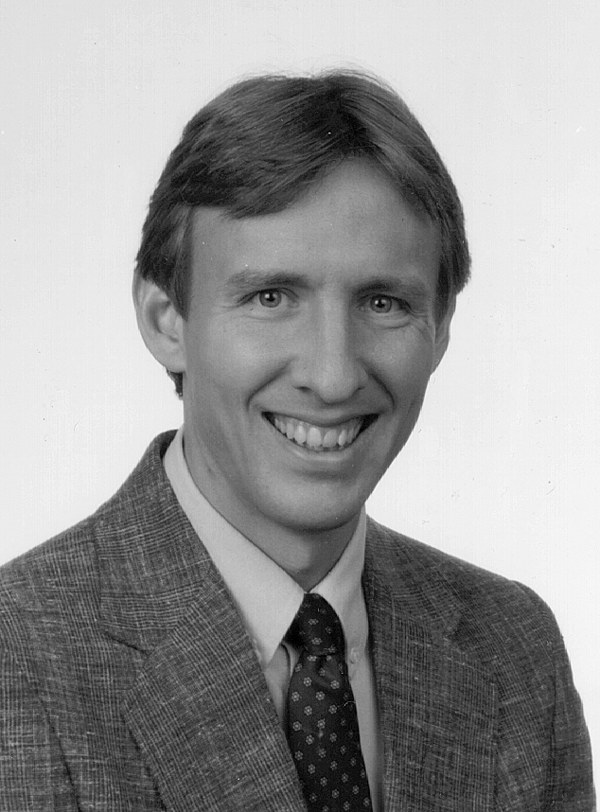 Very few college
freshmen decide to study electrical engineering so that they can design kitchen appliances
for a living. In order to stress the importance of high-frequency circuit design and EMC,
I used to tell my students that they would have to be familiar with these subjects unless
they planned to get a job designing toasters. A few years ago, in a previous Chapter
Chatter column, I further speculated that within five years even toasters would be
sophisticated high-speed microprocessor-controlled devices. Well, you can imagine my
surprise and excitement when I saw an ad in the Rolla Daily News for a “smart”
toaster with a “microchip” brain.
Very few college
freshmen decide to study electrical engineering so that they can design kitchen appliances
for a living. In order to stress the importance of high-frequency circuit design and EMC,
I used to tell my students that they would have to be familiar with these subjects unless
they planned to get a job designing toasters. A few years ago, in a previous Chapter
Chatter column, I further speculated that within five years even toasters would be
sophisticated high-speed microprocessor-controlled devices. Well, you can imagine my
surprise and excitement when I saw an ad in the Rolla Daily News for a “smart”
toaster with a “microchip” brain.
We are already a two-toaster family. We have one toaster that we use infrequently and
another (a gift) that is stowed somewhere in the deepest recesses of our kitchen cabinets.
We didn’t need another toaster, but I thought I’d stop by the local Wal-Mart and
look at one. They had several “smart” toasters on display and I checked to see
if any of them had FCC Compliance labels. They didn’t. Of course, home appliances are
exempt from FCC emission requirements, but I began to wonder if a smart toaster would
interfere with nearby radio or television receivers. Fifteen minutes later, I was the
proud owner of a new “smart” toaster.
As soon as I got it home, I plugged it in and used a portable FM radio to scan for
signs of unintended EM emissions. I was surprised to find that there was absolutely no
toaster-induced interference anywhere in the entire FM band. I threw the toaster in the
car and took it to the laboratory. A quick scan revealed that other than a small amount of
low-frequency broadband emissions, the toaster was dead quiet!
I pulled off the knobs, bent some metal tabs, and removed the plastic housing to reveal
the tiny printed circuit board that housed the microchip “brain”. With a few
more snips and cuts, I was able to remove the board from the toaster and power it up on
the bench. The “brain” was a small dot with 5 leads. Probing just above the
surface of the dot and along the 5 leads confirmed that this was an analog device. The
microchip “brain” was not a microprocessor at all. I’m still not sure
exactly what it is, but clearly the design of this toaster did not require any special
expertise in EMC or RF design. At least for now, students who skip the RF and EMC courses
in the undergraduate EE curriculum can still find gainful employment as toaster designers.
But times are changing. Consumers are demanding more from their home appliances. Before
long, knobs and dials will be obsolete.
Homeowners will tell their appliances what to do and the appliances will do it. Don’t
try to sell me a half-witted toaster with a 5-leaded brain. I want a toaster with the
latest high-speed digital technology. I want a toaster with a fast RISC processor and
gigabytes of RAM. I want a toaster that communicates with toast- making professionals via
the Internet. I want a toaster that knows who I am, knows what I want, and knows how to
make toast just the way I like it.
The toaster on our kitchen counter has a dial with numbers from 1 to 5. A higher setting
is supposed to give you darker toast. I don’t pay any attention to the setting
because no two slices of toast ever come out the same. Our new “smart” toaster
is supposed to be more consistent, but I can’t really say for sure. These modern
appliances are a lot easier to take apart than they are to put back together.
Central New England
John Clarke reports that the September meeting of the Central New England
chapter was a joint meeting of the EMC and Product Safety Societies. The featured speaker
was Wayne Hunter of GE Medical Systems in Milwaukee. The title of Wayne’s
presentation was “Electromedical Device EMC, Product Safety and the FDA GMP.”
The presentation provided information about EMC requirements for electromedical device
manufacturers. EMC is now required for these devices under section 820.30 of the FDA Good
Manufacturing Practices (GMP). GMP will require all electromedical manufacturers to
provide information regarding the intended EMC environment as well as verification data
for new products. The impact of the new FDA GMP on product safety was reviewed. The new
GMP went into effect on June 1, 1997 with a transition period until June 1, 1998. This
requirement directly affects finished device manufacturers and indirectly affects their
subcontractors.
Additional information was also presented in regard to FDA design controls included in
section 820.30 of the code of Federal Regulations, Part 21. The question of changes that
may be required in current CE marking and related issues was also discussed.
The December meeting featured Tim D’Arcangelis, an EMC Consultant from Oakdale,
New York. Tim’s topic was “RF Power Requirements For Radiated Immunity
Testing.” The presentation centered around the IEC 61000-4-3 standard as it imposes
the most demanding radiated immunity test requirements. All other standards may be
considered subsets of this comprehensive IEC test. The presentation discussed power
amplifiers, the anechoic room, harmonic power, antenna performance, the fallacy of
radiated immunity testing below 80 MHz and safety considerations. The written procedure
for the standard is considered deficient and this can lead to gross testing errors.
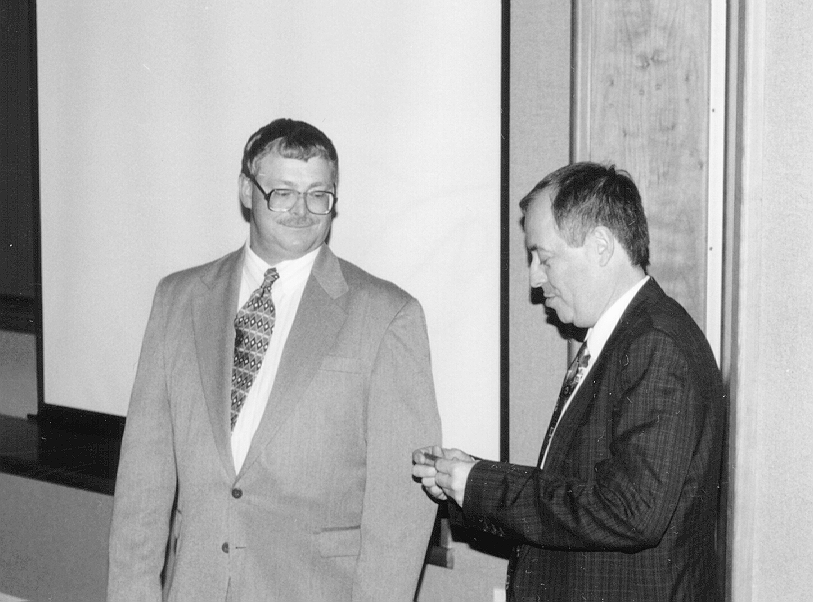 |
Wayne Hunter of GE Medical Systems
(L) was the featured speaker at the Central New England Chapter's September meeting
presided by Chapter Chairman Mirko Matejic (R).
|
Chicago
Steve Laya reports that the December meeting of the Chicago Chapter featured a
“Comparison of TEM Cells, GTEM Cells and Anechoic Chambers” presented by Chase
EMC. The presentation reviewed the benefits and limitations of these test environments.
The Chicago chapter continues to have strong attendance at meetings. They have been
experimenting with sending the meeting notices and meeting reminders using email. They
have found that they can use email to remind everyone of the meetings a day or two in
advance. Also, they plan to use email to inform the membership when a meeting needs to be
cancelled due to weather or for other reasons. Contact mmartin@dlsemc.com to be added to
the email list.
Germany
Markus Petirsch reports that there was a meeting of the German IEEE EMC Chapter in
Hannover on November 19th. The main topics of the chapter meeting were the reports of the
chair and vice-chair, the reports of the Numerical Field Calculation Group and the
Education Group, and the election of the chapter board.
The chairman, Dr. Sturm, thanked chapter members for their activities like the
organization of symposia and presentations last year. The vice-chairman Prof. Garbe
announced the success of the EMC Symposium in Guenzburg organized by the German IEEE EMC
Chapter and the German VDE. In 1998, the German IEEE EMC Chapter will be a sponsor of a
series of presentations planned for May and June at the University of Hannover. Prof.
Mrozynski reported for the working group “Numerical Field Calculations” which
created 14 configurations and problems to benchmark different calculation tools. The
simulations of the numerical problems will be performed in small groups. Prof. ter
Haseborg summarized the activity of the “Education” group. The main activities
were restricted to locations near Hamburg last year. He suggested that similar activies be
sponsored in other cities.
New board members were also elected at this meeting. The old chairman Dr. Sturm retired
and is now the past-chairman. The chapter would like to thank Dr. Sturm for his
activities. The new Chairman is Prof. Garbe. Prof. ter Haseborg was elected Vice-Chairman.
The Educational Activities officer is now Dr. Dancau. The new Technical and Scientific
Activities officer is Mr. Petirsch. Prof. Gonschorek was elected as Treasurer. The
officers of the Work group for Standards are Mr. Harms and Mr. Moehr. Prof. Mrozynski was
re-elected as officer for Numerical Field Calculations Workgroup and Dr. Dancau is the
officer for the Education Workgroup.
Israel
November and December were very active months for the Israel EMC Chapter.
| Israel Chapter Officers (left to
right) Eli Milshtein, Vice Chairman, Elya B. Joffe, Chairman, and Moshe Henig, Secretary,
under the banner stating "Welcome to National Quality Week Activities, 14-19
September 1997." |
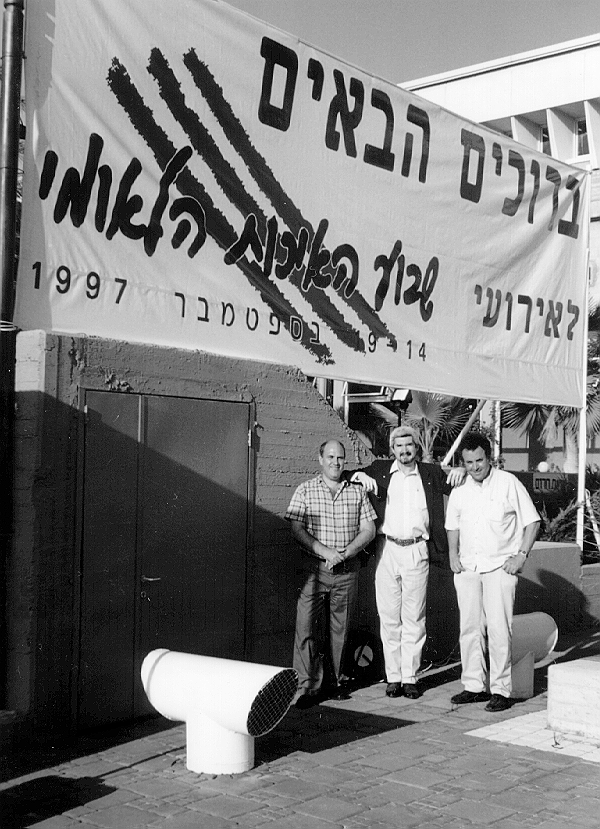 |
IEEE President, Dr. Charles (Chuck) Alexander, visited Israel by the invitation of
Israel IEEE Section Chairman, Dr. Anthony Weiss. On November 17, a meeting of all IEEE
Israel Section Officers and Chapter Chairmen with the IEEE President took place at the
Tel-Aviv University. The next day, the Israel IEEE EMC Chapter sponsored a visit of the
IEEE President, his wife and delegation to Telrad, a Hi-Tech Telecommunications Company,
and a sponsor of the Israel IEEE EMC Chapter. The President and delegation were welcomed
by the Vice President of International Marketing and later were met by the President of
Telrad. Later, the President and delegation were invited to visit the super-modern
production line, where many of its products, later found in telecommunication centers
worldwide, are manufactured. Following the visit, a Certificate of Appreciation was
presented to the President by the Israel IEEE EMC Chapter.
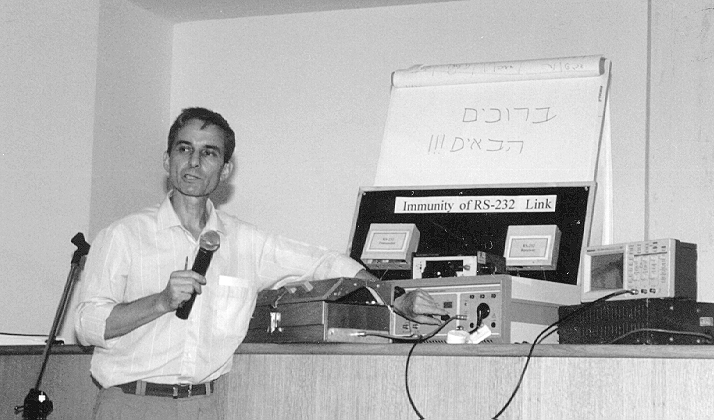 |
Dr. Alex Axelrod, Israeli Chapter
member, is show demonstrating "Electrical Fast Transients/Bursts" at the
Workshop held in the Israeli Institution of Standards.
|
The December meeting was a full-day workshop on EMI Control Devices and Techniques
sponsored by Telrad. Participation in the meeting was great!
There were over 80 attendees, of which over 30 were IEEE members.
Participants arrived from places as far as 100 km from Tel-Aviv.
After a short welcome by Chapter Chairman, Elya B. Joffe, a welcome address on behalf
of Telrad was given by Mr. Reuven Rabinovitch, Vice President for Quality Management at
Telrad. In his presentation, he highlighted the policy of Telrad to design EMC into its
products, and thus the importance of familiarizing all design engineers in the company
with EMI control techniques. This is exactly the objective of the EMC Chapter in Israel in
holding such workshops - increasing the awareness of industry to the importance and
benefits of EMI control “from the start”.
Following the welcome address, elections for the Officers of the Chapter for the year
1998 took place. Elya B. Joffe was re-elected as Chapter Chair. Eli Milshtein was
re-elected Vice-Chair. Moshe Henig was re-elected Secretary/Treasurer. Dr. Alex Axelrod
was elected as the new Technical Activities Officer. Dr. Jacob Gavan was elected Student
Activities Officer.
We wish good luck and success to all newly and re-elected officers, and look forward to
yet another fruitful and active year.
Following the elections, a brief summary of the annual activities was presented by the
Chairman, Elya Joffe, followed by an announcement of future activities in Israel and
abroad. Special emphasis was placed on MELECON’98 and EUROEM’98 which will take
place in Israel in 1998. After this introduction, the following technical presentations
were given: “RFI Filter Connectors for Military and Commercial Applications”, by
Mr. Avi Inbar of Bar- Teck; “Active Power Line Filtering”, by Mr. Nehemia Niv
and Haim Neerman of Actil; “Combined E3 Mitigation/Protection”, by Mr. Tino
Nackson and Amir Cohen of Amtech; “EMC Considerations in Grounding Design on a
Printed Circuit Board”, by Dr. Alex Axelrod of EMI Test; “Lightning as a Source
of RFI”, by Dr. Itzhak Israeli of Lotan Engineering; “Analysis and Design of
Transient Suppression Circuits using Pspice,”by Mr. Moshe Shechter of Rafael/ADA;
“From the Diary of a Clinic Engineer”, by Dr. Alex Vilenski of Rambam Hospital;
and “RFI Skirt in Cellular Systems”, by Mr. David Peso of Telrad.
MELECON’98 (IEEE Mediterranean Electro-Technical Conference) will be held on
May18-20, 1998, in Tel-Aviv, Israel.
Chapter members were very busy in the last few months assisting in the review process
of the abstracts and summaries which were submitted from many countries. Over 15 papers in
the field of EMC were submitted, and eight were approved, from several countries,
especially in Region 8.
The Chapter Officers held a Steering Committee meeting following the Chapter meeting at
Telrad to discuss preparations for the IEEE International EMC Symposium to be held in
Israel in May, 2003. An agreement has been reached with the National Committee of URSI,
Commission E (EMC) to co-sponsor this Symposium. Additional Chapter meetings and
activities are scheduled for1998.
Information may be found on the Web Sites of the Israel IEEE Section:
https://www/eng.tau.ac~il/ ~ajw.ieee.html. Again we encourage IEEE members from the Middle
East, in particular from Egypt, Jordan and the Palestinian Authority (PA) who wish to
participate in our activities, to contact the Israel EMC Chapter Chairman who will welcome
all wholeheartedly.
Los Angeles
The Los Angeles Chapter had the pleasure of Dr. Lothar (Bud) Hoeft’s company as he
tutored some 35 attendees on the basics of shield transfer impedance at the January
meeting. Bud is an independent EMC consultant and Certified EMC Engineer who resides in
Albuquerque, NM. He presented the basics of shield transfer impedance and numerous
measurements of everything from connector backshells to spiral wound shielded cables using
vacuum deposited aluminum on mylar. He spoke of the effects of torque on connectors and
how it affects shielding effectiveness—more torque, lower impedance.
Attendees came away with an understanding of the “characteristics” of a
shield transfer impedance curve (i.e. what to look for—dc resistance, diffusion break
frequency, and square root of frequency term). The talk lasted for 2-1/2 hours and most of
the attendees were still interested at the end. The audience was given a chance to
“escape” when the overhead projector light bulb burned out. Several EMC
engineers rushed to correct the problem, but very few left!
Edna and her staff at The Lakes in El Segundo, where the meeting was held, whipped up
wonderful teriyaki chicken and baked codfish dinners complete with all the fixings. Those
who reserved early and showed up on time did not go hungry. We expected to lose a few
attendees due to the “rain”, but we actually ran out of food as several
additional people showed up at the door. Fortunately, Edna whipped up something else to
keep the late comers happy.
For information on the Los Angeles chapter, please contact Ray Adams at 310.662.7878 or
e-mail at r.k.adams@ieee.org
Oregon (& SW Washington)
The Oregon and Southwest Washington Chapter is alive and well during its second year of
existence. Officially, the chapter is within the jurisdiction of the Oregon Section,
concentrated near the Portland metropolitan area, which extends to Southwest Washington.
We have regular attendees and even an officer from SW Washington and hence our long
chapter title.
| Oregon EMC Chapter Meeting
"Fun With Fourier" Lecture Series by Franz Gisin. |
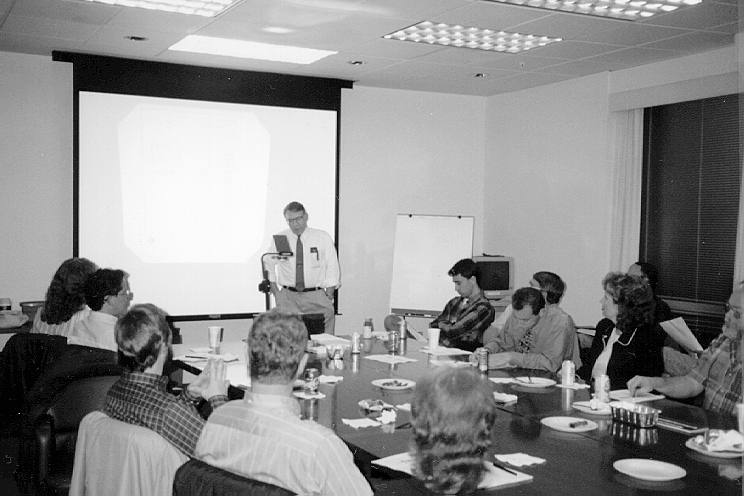 |
The chapter has continued the enthusiasm from its inaugural year. Attendance at chapter
meetings has consistently exceeded 30 people, with expectations that the membership will
steadily increase as more people become aware of our existence. We have been fortunate to
have had high caliber lecturers. Mr. Franz Gisin’s “Fun with the Fourier
Series” presentation on October 1 lived up to expectations. (I have included a
picture for proof. Note that all eyes are focused on the presentation!!) On October 30,
Mr. Art Wall from the FCC gave an update on US/EU Mutual Recognition Agreement details.
Mr. Wall showed that even government representatives can have some fun as he not only
partook in the chapter’s Halloween Hat contest, but was the unanimous winner!!!
In November, Mr. Dan Hoolihan provided information on updates to the ISO/IEC Guide 25
lab accreditation guidelines. The presentation was very audience participative. In fact,
things livened up even more during the question and answer period. It became apparent that
what was important to this audience were the details of “how to pass an ISO/IEC Guide
25 EMC laboratory quality certification audit.” Mr. Hoolihan came well prepared and
pulled out a set of slides from his back pocket and proceeded speaking for an additional
30 minutes!
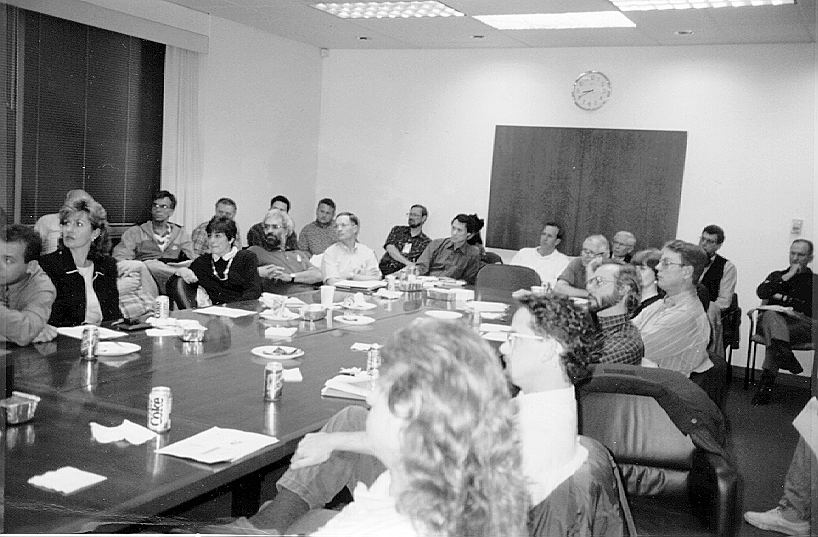 |
Note: All eyes focused on Mr. Franz
Gisin's exciting presentation!
|
The chapter is excited about co-hosting a Vendor Exhibition on EMC Products and
Services on June 29 in Portland, Oregon. The event will be held in conjunction with an
Electromagnetic Compatibility (ANSI ASC C63) EMC Measurement Uncertainty Workshop and ANSI
ASC C63.4 Workshop on the Measurement of Radio-Noise Emissions sponsored by the US EMC
Standards Corporation in cooperation with the American National Standards Institute,
Accredited Standards Committee C63 (EMC). For those of you interested in these workshops,
please sign up and come visit the beautiful Northwest June 29 - July 1. Contact Henry
Benitez, Chapter Chairman, for more information at phone 503.627.1217 or e-mail at henry.w.benitez@tek.com
Ottawa
Gary Wong reports that the speaker at the December meeting of the Ottawa chapter was
EMCS Distinguished Lecturer, Dr. Todd Hubing. The presentation was titled, “An EMC
Engineer’s Guide to Electromagnetic Modeling.” Dr. Hubing presented an overview
of various commercial and non-commercial software packages marketed to EMC engineers.
Philadelphia
Richard Haynes of Richard Haynes Consultants was asked to give an after dinner talk at
the October meeting of the Philadelphia chapter. The presentation was abstracted from the
two popular courses: “Executive Summary: EMC/EMI/ESD Related to Corrosion and
Materials Reliability Issues” and the more detailed technical course. The members
were so interested in the subject matter that the talk had to be terminated after one and
a half hours.
San Diego
The December meeting of the San Diego Chapter of the IEEE EMC Society featured Mr.
Henry Osgood (Chapter Vice Chair) who discussed spectrum analyzer performance. This
discussion was very well received by the local EMC members and presented an analysis of
spectrum analyzer performance features and their relative merits in spectrum analyzer
applications. The items covered included frequency and phase modulation, resolution
issues, amplitude issues, display resolution, spectral purity, deviation accuracy,
sensitivity, functions of a preselector, onscreen dynamic range and measurement error
values.
Audience participation was encouraged and thought-provoking questions were entertained.
Seattle
Art Wall of the Federal Communications Commission (FCC), spoke at the October meeting
on the “Status of the United States-European Union Mutual Recognition
Agreement.” The meeting was held on the evening of October 30, at a restaurant in
downtown Bellevue, just east of Seattle. This being the night before Halloween, the
chapter added a ghoulish air to the evening by providing Halloween candy on the tables and
suitable decorations. In fact, the speaker surprised the audience by donning a crazy wig
and witch’s hat when he was introduced! Mr. Wall spoke about the current status of
the United States-European Union Mutual Recognition Agreement (MRA). He elaborated on the
steps being taken to implement the Agreement. Sectors covered included telecommunication
equipment and electromagnetic compatibility, notably electrical safety, recreational
craft, pharmaceutical GMP and medical devices. Mr. Wall also addressed the recent and
proposed changes to the FCC equipment authorization program. Northwest EMC Inc. generously
sponsored the cost of the dinner so a good time was had by all. Boo!
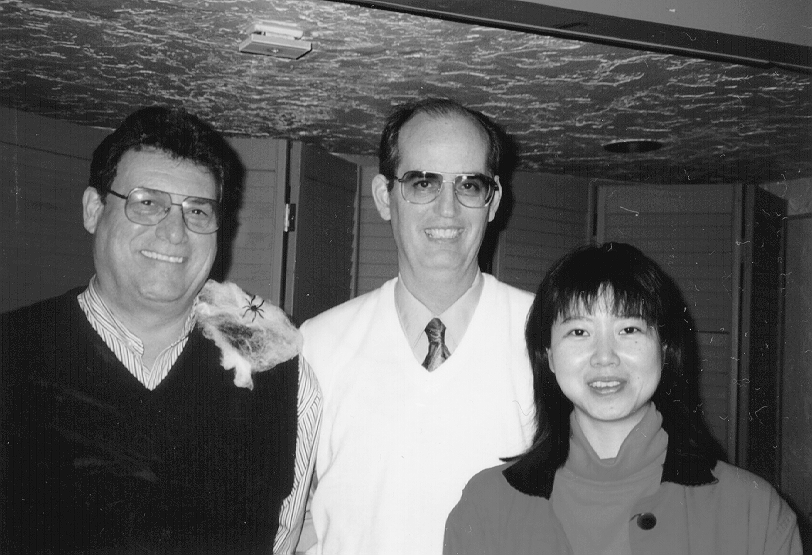 |
|
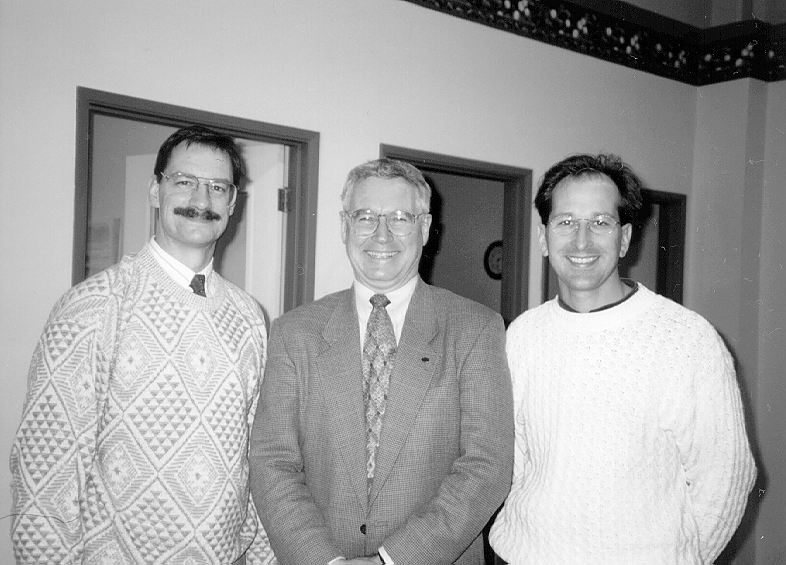 |
Seattle Chapter
speaker Art Wall of the FCC (C) enjoys a lighter
moment with Northwest EMC's Jerry Page (L) and Kitty Tam (R).
Northwest EMC sponsored the Halloween theme dinner prior to
the presentation. Note the spider and web on Jerry's shoulder! |
|
Hosts at the
November Seattle Chapter meeting included
Pat Andre (L) and Mark Darula (R) of CKC Labs in Redmond.
Speaker Dan Hoolihan (C) is clearly enjoying his visit to the
rainy Pacific Northwest! |
In November, Dan Hoolihan of TUV Product Service, New Brighton, Minnesota spoke on
“A Comparison of the Third and Proposed Fourth Editions of ISO/IEC Guide 25: General
Requirements for the Competence of Testing and Calibration.” The Fourth Edition of
ISO/IEC Guide 25 was circulated for review and comments the first half of 1997. Mr.
Hoolihan’s presentation compared and contrasted the 1990 third edition with the draft
fourth edition. Paragraph by paragraph comparisons were made between the two versions of
the Guide and differences/additions between the two editions were highlighted. Comments
from reviewers of the 1997 draft were discussed. Implications on testing lab accreditation
were emphasized. This evening meeting was held at CKC Labs in Redmond. CKC Labs and
Lindgren RF Enclosures provided free pizza and soft drinks. It is still being debated
among the chapter officers if the free pizza or the excellent speaker was the bigger draw
for this meeting. (Just kidding Dan!)
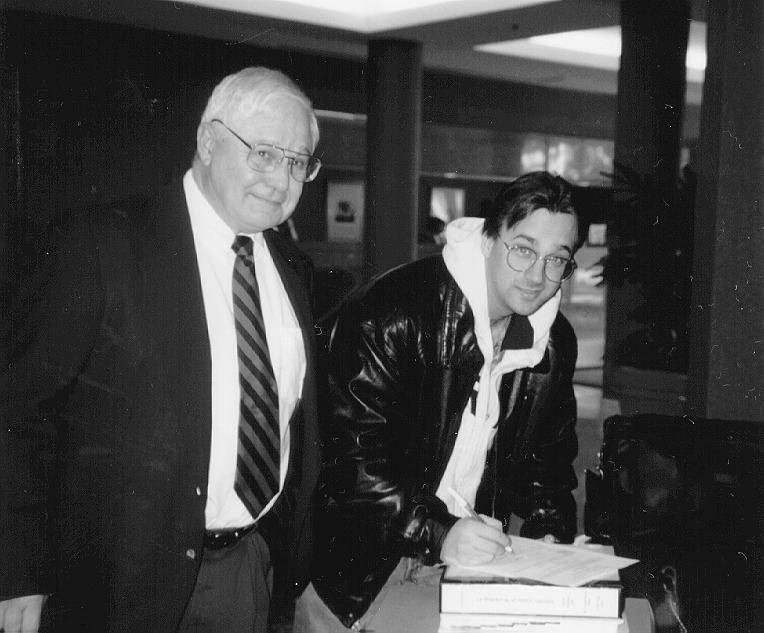 |
|
 |
Washington
Laboratories, Ltd. of the Washington DC/Northern
Virginia Chapter lent administrative support to the
EMC Measurement Uncertainty Workshop and ISO/IEC
Guide 25 Workshop held on October 22-24 in Linthicum, Maryland.
Signing in are Bill Lubitz (L) of Harley Davidson Motor Company
and Richard Schmidt (R) of Yazaki North America
|
|
Member Services
Director Todd Hubing (R) actively promoted
membershipin the IEEE and EMC Society at the Wireless EMC
Forum on October 27 and 28 in Dallas, Texas. This event
was sponsored by the University of Oklahoma's Center for the
Study of Wireless EMC. The program attracted representatives
of the medical and automotive electronics industry, such as
Poul Andersen of Chrysler (L) and Jim Polonis of the
Southwest Research Institute (C). |
Southern Maryland
Wayne Devereux reports that during 1997, the Institute of Electrical and Electronics
Engineers (IEEE) Southern Maryland Communications, Computers and Electromagnetic
Compatibility (EMC) Chapter held 12 technical and business meetings, once every month of
the year. The meetings were held regularly on the last Monday of every month, with dinner
meetings held at the Roost restaurant on the 1st month of each quarter and brown-bag-lunch
meetings held at Veda Incorporated on the 2nd and 3rd month of each quarter. Regular
meeting notices were issued by postal mailings, e-mail and newspaper articles. All
meetings in 1997 were very well attended throughout the year, averaging around 15 people
for the dinner meetings to 35 people attending the lunchtime meetings, and increasing at
each meeting throughout the year.
During 1997, our Chapter began to schedule IEEE Distinguished Lecturers for our 1st
month of the quarter dinner meetings. For our October dinner meeting, Dr. Pasupathi
Subrahmanyam, from Lucent Technologies, was scheduled to visit the Southern Maryland area
to lecture on Embedded Systems. Unfortunately, our first Distinguished Lecturer had to
cancel his arrival due to the flu, however, a business meeting was still conducted.
Future technical and business meetings for the first half-year of 1998 have already
been planned by the Southern Maryland Communications, Computers and EMC Chapter. The
regularity of a monthly meeting scheduled for the last Monday of each month will be
continued. We are continuing to invite more IEEE Distinguished Lecturers to our dinner
meetings in hopes we can increase our dinner meeting attendance. For more information,
contact Mr. Fred Heather (heatherf%am3@mr.nawcad.navy.mil) or Mr. Wayne Devereux, phone
(301) 863-4290 (wdevereux.paxr@veda.com).
Sweden
In November, the Sweden chapter re-elected the following committee: Dag Bjorklof, of
SEMKO AB, is the chair; Per-Olof Eriksson, of Enator Communications AB, is the vice-chair;
and Mats Backstrom, of FOA AB, is the secretary. During 1997, the Swedish chapter had
three meetings. The topic of the April meeting at SEMKO EMC Center in Stockholm was
“EMC and Medical Equipment.” One presentation, given by Mr. Jan Welinder of the
Swedish National Testing and Research Institute, was titled “Investigation of the
Electromagnetic Environment in Hospitals.” Another presentation, given by Mrs. Eva
Clausson of Medtronic-Vingmed, was titled “Pacemakers and EMC”.
A meeting was held in September at the University of Lund. The topic of this meeting
was “Potential Biological Effects Due to Electromagnetic Fields.” There were
seven presentations representing Swedish authorities, scientists, and the
telecommunication industry.
One of the representatives of the scientific community was Dr. Kjell Hansson-Mild of
the National Institute for Working Life. His presentation was titled “Electrical
Hypersensitivity - the Present Situation.” From the industrial side, Mr. Christer
Tomevik of Ericsson Radio Systems AB gave a presentation titled “Cellular Phones -
Electromagnetic Exposure and Interference.”
The third meeting of the year was held in November at ABB EMC Center in Vasteras. The
topic of this meeting was “Power Electronics”. An overview of the topic was
given by Dr. Lars-Erik Juhlin of ABB Power Systems AB. Other subjects treated were EMC
education and test standards.
Toronto
The December meeting of the Toronto chapter featured Prof. Todd Hubing of the
University of Missouri-Rolla. The subject of Prof. Hubing’s talk was “EMI
Troubleshooting Techniques.”
Return to Contents page
 Very few college
freshmen decide to study electrical engineering so that they can design kitchen appliances
for a living. In order to stress the importance of high-frequency circuit design and EMC,
I used to tell my students that they would have to be familiar with these subjects unless
they planned to get a job designing toasters. A few years ago, in a previous Chapter
Chatter column, I further speculated that within five years even toasters would be
sophisticated high-speed microprocessor-controlled devices. Well, you can imagine my
surprise and excitement when I saw an ad in the Rolla Daily News for a “smart”
toaster with a “microchip” brain.
Very few college
freshmen decide to study electrical engineering so that they can design kitchen appliances
for a living. In order to stress the importance of high-frequency circuit design and EMC,
I used to tell my students that they would have to be familiar with these subjects unless
they planned to get a job designing toasters. A few years ago, in a previous Chapter
Chatter column, I further speculated that within five years even toasters would be
sophisticated high-speed microprocessor-controlled devices. Well, you can imagine my
surprise and excitement when I saw an ad in the Rolla Daily News for a “smart”
toaster with a “microchip” brain.







